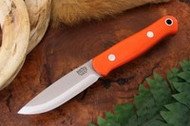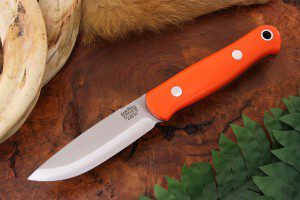The Best Bushcrafting Knife?
21st Apr 2014
A Review of Bark River Knives: Bushcrafter
When it comes to bushcraft/survival knives, how much is enough? How do you make sure your knife will be up to the task? Here’s a product from Bark River Knives that might be what you need.
by Leon Pantenburg of www.SurvivalCommonSense.com
At one end of the bushcraft spectrum is the Bowie/Rambo, knife/sword. At the the other extreme is the tiny keychain knife, such as a Swiss Army Classic. Both are useful, and either might be the best choice for particular situations.
The Bark River Bushcrafter is a medium size, do-it-all knife.
But nobody knows what might come up, so opting for a compromise makes sense. That’s the idea behind the Bark River Bushcrafter.
Bark River Knives wanted to make a knife smaller than their number one selling Bushcraft knife but just as usable in the field. The Bushcrafter was designed to be a compact handful, according to the company, specifically aimed at Wilderness Survival and Wilderness Living.
I’ve reviewed several Bark Rivers, so unpacking the Bushcrafter was not a surprise. The knife showed the quality I’ve come to expect from the company.
I ordered the gaudy orange handle, because this knife will be used in the backcountry, and I don’t want to drop and lose my best survival tool. There are about 80 different versions, so you can get whatever color you want.
There’s the Bushcrafter specifications:
- Overall Length: 8.63 Inches
- Blade Length: 3.875 Inches
- Blade Thickness: .145 Inch
- Blade Steel: CPM 3V @ 60 rc
- Weight: 6.625 Ounces
Blade size: A four-to-five-inch blade is about right for a bushcraft knife, IMO. It is just the size I prefer for skinning big game, but it’s not too big to clean fish. You could also process small game with this length of blade, though I’d prefer a two-to-three inch with a spey tip if given my druthers.
The blade is one-inch wide, which works fine. You’d want a wider blade for a skinner and a narrower, longer blade for filleting fish. For overall use, this is a good option.
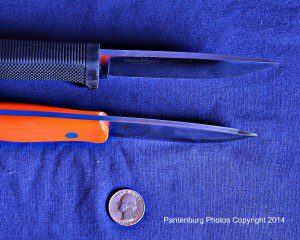
The Bushcrafter’s blade thickness, bottom, is comparable to that of the Cold Steel Master Hunter, and is a good, useable size.
The Scandinavian grind of the blade is a good pick for a bushcraft knife. I like this option because of the ease of sharpening. All you do is lay the bevel flat on a whetstone and start to work. It is also easy to touch up the blade with a butcher steel and/or leather hone. Generally, with any knife, it is best to hone the edge periodically to keep it from ever getting dull and dangerous.
Blade thickness: The .145-inch thickness works well. There is enough spine to make a stout cutting or splitting wedge, if needed. Thinner or thicker would create different benefits, but we’re looking for a good, over-all design here.
The handle is made of micarta, is 4-7/8-inches long, and is very comfortable for my glove-size large
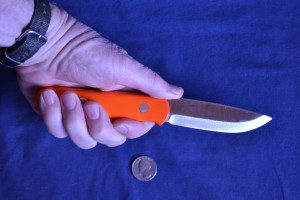
The Bark River Bushcrafter handle fits my large-sized hands very well
hands. The handle design fits me very well, and that makes the knife secure to use.(Before buying any bushcraft knife, consider if you can easily use it while wearing gloves.)
The full-tang construction is sturdier than other options, and I like the security. Only the most dire of circumstances could force me to pound away at something with the pommel of a knife, but it’s nice to know the Bark River could handle the abuse.
Steel: A beautiful, custom knife is not worth anything if the steel won’t hold an edge. The Bushcrafter is made of Crucible CPM 3V at a hardness of 60 rc. According to to the Crucible Industries website:
“CPM 3V is a high-toughness, wear-resistant tool steel designed to provide maximum resistance to breakage and chipping in a high wear-resistance steel. CPM 3V is intended to be used at 58/60 HRC in applications where chronic breakage and chipping are encountered in other tool steels, but where the wear properties of a high alloy steel are required. CPM 3V offers the highest impact toughness of any tool steel with this range of wear resistance.”
The Bushcrafter holds an edge incredibly well. In any of the CPM 3V blades tested, I had to deliberately dull the steel to check out sharpening. All the BRs were quickly brought it back to razor sharpness with a few swipes of my grandpa’s butchering steel.
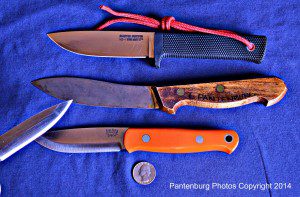
The Bushcrafter, bottom, has a good belly for skinning. The Russell Sheepskinner, center, and Cold Steel Master Hunter have been used extensively, and have proven designs.
Drop point: This is one of my favorite points. The Bushcrafter point is about one-quarter-inch down from the spine. This results in more belly near the tip, which makes for a better skinning knife. This point is good for over-all use. Actually, IMO, a spear point is better for an overall bushcraft knife, because it centers the point near the middle. This will allow you to drill holes, skin big animals effectively, carve wood and do other bushcraft activities quite well.
But given a choice, I’ll take the Buschcrafter drop point, since I am more likely to use it for skinning and game processing than carving.
Lanyard hole: Every rigid blade knife should have a lanyard hole, IMHO. It allows rigging a safe hold on the knife under potentially unsafe conditions.
The Bushcrafter is supplied with Bark River’s Bushcraft “A” Sheath. I’ve carried several BRs in this this model of sheath, and it’s a durable secure sheath.
Choose carefully when picking a knife for bushcraft. It may end up being the only survival tool you have if a survival situation happens. In the meantime, that knife must comfortably and safely do a lot of other tasks.
The Bark River Bushcrafter is a knife that can be relied on, and it might be a best choice for you.

